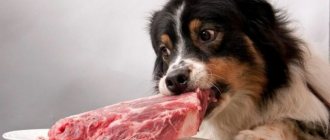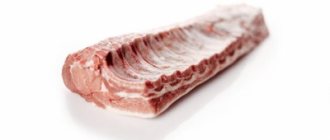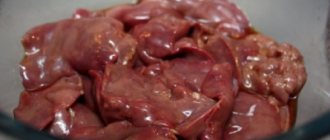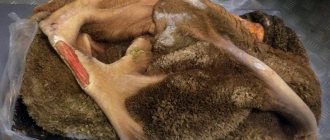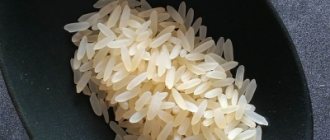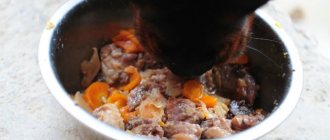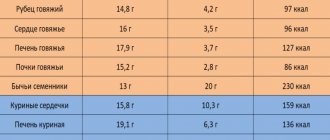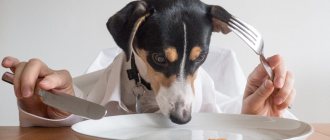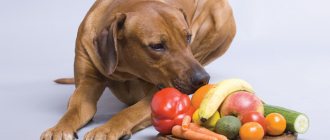Can a dog eat pork? This question arises for many owners of furry pets. As for the norms and prohibitions regarding cakes with cream, custard, sweets, hamburgers - everything is clear here. This is unhealthy food that leads to excess weight gain, illness and poisoning of the body. Why can’t dogs eat pork? It seems like it’s a simple and natural product?
Are there any benefits to eating pork?
It is easily digestible, and the fat is not as harmful to the heart and blood vessels as beef fat. It contains much more B vitamins than beef and lamb.
Externally, this product differs from other types of meat:
- much lighter in color than beef and other types of meat: it is light or pink-red with a grayish tint;
- thick layer of subcutaneous fat and marbling;
- white internal fat.
Pork is rich in vitamins, microelements and valuable amino acids, it contains:
- magnesium and zinc, necessary for the proper functioning of the cardiovascular system, as well as calcium, sodium, selenium, potassium, phosphorus, manganese, copper; and
- lysine is an amino acid that plays a major role in the formation and strengthening of bones;
- vitamin E, which has an antioxidant effect;
- vitamin B7, necessary for the metabolism of micronutrients. Most of it is in the liver and kidneys;
- vitamin A and choline (sometimes called vitamin B4);
- Oleic and linoleic acids (found in fat) are the most essential unsaturated fatty acids for the body.
The calorie content of pork is 227 kcal/100 g of product, the protein content is 22%, fat is 9%.
Food with added pork
Expensive dry food (holistic or super-premium) for dogs actually contains low-fat steamed pork meat. Such products usually undergo the necessary processing and meet established quality standards.
Pork, which is used in dry food, contains the required amount of phosphorus, potassium, zinc, iron, amino acids, and B vitamins.
When purchasing dry food, it is important to familiarize yourself with the percentage of fat content indicated on the packaging. The food is supported not only by strict production standards, but also by the fact that the product is often hypoallergenic.
If you decide to give your dog pork, you can purchase pork heart and lungs - these products are perfect for feeding your pet, since not only meat contains a large number of useful microelements. As with meat, the heart and lungs must be pre-processed.
Is it possible to feed a dog
Despite all the richness of nutrients in pork, veterinarians warn: giving meat to a dog is extremely undesirable. This can lead to dangerous diseases for the animal.
Pigs are carriers of the dangerous Aujeszky's disease, otherwise called pseudorabies, pruritic plague, and infectious bulbar palsy. This is an acute infectious disease, unfortunately, with an unfavorable prognosis. The reason for this is the current lack of effective drugs against the background of the high resistance of the virus to low temperatures and the influence of possible chemicals and reagents.
The disease is acute, in animals it manifests itself as severe unbearable itching, leading to scratching, damage to the central nervous system, fever, paralysis of the limbs, and convulsions. Pseudorabies is most dangerous for small puppies, young animals with fragile immune systems, and dogs with weakened immune systems.
Another negative factor due to which experts do not recommend feeding your dog pork is the risk of infection with parasites. Trichinella larvae may be present in pig meat, so if a dog eats raw meat, it can become infected with trichinosis. The larvae do not die even when cooking meat; they live in the intestines for up to several months, in the muscles for years.
In addition, from low-quality meat contaminated with helminths, a dog can become infected with pork tapeworm, which affects the central nervous system of the animal, resulting in death. Animals often become infected with intestinal helminths and toxocara from pork meat. The latter are dangerous because their larvae are able to wander throughout the body, affecting internal organs. Helminthiasis is difficult to treat, so it is better to exclude pork meat from the dog’s diet - this is what veterinarians recommend. Or purchase meat only from trusted sellers and with documents confirming veterinary control confirming the safety of the product. Another option is to give your dog boiled pork occasionally.
Important!
In winter, it is allowed to add small lean pieces of meat to your pet’s food in small quantities no more than once a week.
Briefly about the main thing
- When deciding to diversify your food with pork, you act at your own peril and risk. Pigs are most often susceptible to various diseases.
- To reduce the risk of infection, do not buy meat and offal at spontaneous markets - only from trusted sellers.
- Buy lean meat, and do not feed pig meat more than twice a month. Keep in mind that the digestive systems of dogs and humans are different.
- Never give raw pork or offal to dogs. Large pieces of meat should not be given.
- The animal can be given dry food containing pork.
Is it possible to give pork offal and bones?
It is not advisable to give pig bones to dogs. There are several reasons, and first of all it is the danger of infection by parasites. Another danger is the risk of mechanical damage to the walls of the stomach and intestines from sharp bone fragments.
Of the by-products, experts consider the lungs to be the safest. They can be given occasionally, replacing meat and in combination with other offal (boiled only!). Kidneys are the best digestible by-products; they are considered a dietary product due to their low fat content. The kidneys contain vitamins A and D, selenium, and amino acids.
The heart contains an important amino acid - taurine, which is necessary to strengthen the cardiovascular system and improve immunity. It is a source of protein, as well as microelements - iron, potassium, magnesium.
Pork lard is a very fatty product that can harm the health of the animal and disrupt the functioning of internal organs and systems. It should not be given to dogs, nor should it be given to pig liver. And the skin can be added to food to improve the condition of the skin, strengthen bones and joints.
Is it worth giving meat that has undergone heat treatment?
If you are going to feed your dog pork, be sure to choose less fatty cuts; shoulder or tenderloin are fine. Do not forget to take care of the heat treatment of the product. Before adding it to food, veterinarians recommend first freezing the meat and then boiling it for at least an hour at a temperature of at least 70C.
Heat treatment, unfortunately, cannot always destroy parasites. For example, with trichinosis, worm larvae “sit” in special capsules that cannot be destroyed under the influence of high temperatures.
Never give your pet unprocessed meat, oils or offal, even if you purchased them from a trusted seller. It is worth noting that some diseases are not dangerous to humans, but can be fatal to a pet.
Should you believe the myths?
There are many myths among dog breeders about feeding your pet, including pork. Which ones should you believe and which ones should you not?
Some argue that pork is difficult to digest. This is partly true, but only if you feed fatty meat. If the fat layer in it is no more than 40%, then the process of digesting food is delayed for 12–15 hours instead of the usual 6–7. Fatty foods put a lot of stress on the digestive organs, and this is fraught with serious pathologies.
There is an opinion that fatty meat and lard increase blood cholesterol in dogs. However, to date, no studies have been conducted on cholesterol levels in pets, so it is impossible to either confirm or refute this hypothesis. Lean meat in small quantities and properly cooked is unlikely to harm the dog.
Another myth is that pork can cause volvulus in a dog. This is a lie, such food is not capable of causing pathology, but it is dangerous to give your dog serious physical activity immediately after eating. And this applies not only to pig meat, but to any food. You can give your dog active exercise no earlier than 2 hours after feeding.
Pig meat is fattier than other types of meat, but fats must be present in the dog's diet. In large quantities, they can cause problems with the stomach, pancreas, obesity and other diseases, and it does not matter whether the dog received fats from pork or other fatty foods. Therefore, this particular type of meat should not be ostracized. A lack of fat can also lead to undesirable consequences for your pet: dry skin, brittle and dull coat, and skin diseases.
When Pork Isn't Good for Dogs
Before giving your dog pork, it is very important to know what is safe and what is not.
Firstly, dogs can only eat cooked pork. If pork is raw or otherwise undercooked, it is dangerous for both people and dogs because it may contain the Trichinella parasite, which can cause pain, vomiting, stomach upset, diarrhea and other less serious side effects.
What about pork in a raw diet for dogs?
The difference here is that the pork has been processed properly for this type of consumption, usually by freezing it for a period of time, to effectively kill those pesky parasites. Standard raw pork from the grocery store, even high quality pork, has not been processed this way.
Secondly, it is worth noting that dogs can only eat pork. The ingredients we use to flavor pork—like garlic, onion, chili powder, mustard, and lots and lots of salt—are potential dangers to our pups' stomachs.
That means the cooked pork on your plate, including that piece of fried bacon, is too decadent for your canine companion. No ham or bacon for the dog and no jerky pork products.
Additionally, dogs should not eat pork fat.
Most pork products are high in fat, and many have fat left on them after cooking.
This fat is very difficult for dogs to digest and can be a warning sign of serious stomach upset, especially due to inflammation and irritation of the pancreas.
And finally, no boiled pork bones for dogs. Any cooked bone can splinter and cause choking and/or rupture of the digestive system. Stick to the bones and antlers you buy at the pet store.
Veterinarian recommendations
To keep your pet safe, it is best to visit a veterinarian before giving him pig meat. He will assess the animal's health and give his recommendations. The following are common to all owners:
- Even the healthiest dog should not be fed fatty meat;
- raw meat is a potential source of various diseases. Even deep freezing will not get rid of all types of parasites, viruses and bacteria. Only boiling meat can destroy them as much as possible (but not completely);
- It is not advisable to give pork to dogs that are overweight and prone to rapid weight gain, pathologies of the heart and blood vessels, diseases of the liver, stomach and intestines;
- You cannot store pork for a long time, even in the freezer: the maximum shelf life is in the refrigerator - up to 4-5 days, in the freezer - up to six months.
Important!
When cooking, do not add salt and spices to meat, they are harmful to pets. Fried food should not be given.
Chicken can replace pork in a dog's diet. It is a rich source of protein, meat is easily digestible and contains all the vitamins, minerals and amino acids necessary for the animal.
But is it safe to share?
Dogs are carnivores by nature and the majority of their diet consists of meat proteins. For this reason, many dog parents don't even think about giving them a piece of pork or even the aforementioned piece of bacon.
The problem, however, is that there are quite a few variables that need to be considered in order for your dog to safely enjoy pork, and the pork we eat usually fails the test.
Pork as part of a dog's diet - pros and cons
Dogs are the closest descendants of wolves. Based on the nature of the origin, the first serious doubts arise about the relevance of the pork ban. Wolves don’t pick and choose what they have for lunch; whoever they catch is what they eat. But there is also a counterargument: a wild pig grows in conditions different from a farm, moves a lot, does not use antibiotics, eats “clean” food and has normal hormonal levels. So, can a dog be fed pork depends on how the pig is kept? - Is not a fact!
Raw or cooked
Although raw meat is a natural food for dogs, the answer to this question is controversial. Both raw and cooked foods have advantages and disadvantages. When making a decision, the owner must clearly understand the benefits and possible harms of the chosen feeding method.
Raw meat
| pros | Minuses |
| High nutritional value Rich in essential amino acids Correct formation of the animal’s skeleton and muscle tissue Prevention of anemia - increasing the level of hemoglobin in the blood Improvement of the immune system and overall endurance of the body Prevention of diseases of the animal’s teeth and jaws by chewing coarse meat fibers | Danger of infection with helminths and infectious diseases |
Cooked meat
| pros | Minuses |
| Safe against parasites and some infectious diseases | After heat treatment, meat loses some of its beneficial properties and decreases in volume. Boiled meat reduces satiety and nutritional value. |
The high concentration of hydrochloric acid in a dog's stomach allows it to disinfect stale food contaminated with pathogenic microorganisms. Despite this, you should only feed your dog raw meat if you have full confidence in its safety and high quality.
Only meat from farm animals that is purchased in a store can be considered uncontaminated. It is subject to mandatory sanitary and veterinary control.
Raw meat from wild animals, such as small rodents, is strictly not recommended for your dog. Hunting dog breeds are at risk when walking through the forest with their owner.
To protect raw meat of questionable quality, you can place it in the freezer for several days. Parasite eggs die from a sharp drop in temperature.
Important! When preparing a meat dish for a dog, you should not add salt or other spicy spices. If you are thinking about whether you can treat your pet to a tasty piece of smoked meat, it is better to refuse it. Food additives in such meat have a negative effect on the condition of the dog’s liver.
The broth left over after cooking meat should not be fed to the dog - it is too concentrated. You can use it to cook cereal porridge or vegetables.
Pork is more often than other types of meat infected with parasites and viruses - True!
By the way, pigs “love to live in the dirt” is a myth, but that’s not what we’re talking about now. Total disregard for sanitary and hygienic standards for keeping pigs, violations of rearing technology and veterinary control have had devastating consequences for years. Stimulation of growth and inhibition of the hormonal system of animals has led to the fact that the next generations have virtually no immunity to a number of diseases. Pigs are intermediate carriers of the following diseases:
- Helmitiasis and its subspecies. Worms that affect the intestines and digestive system.
- Toxocariasis (nematodosis) is an extremely dangerous disease. The worms themselves are not dangerous, but their larvae can migrate throughout the dog’s body, literally eating the heart, lungs, liver, kidneys, brain and other organs.
- Latent rabies (Aujeszky's disease) is a transient and fatal disease for dogs, but not dangerous for humans. The main problem is the lack of control over pork contamination. Meat is not tested for the presence of the virus before being sold.
- Teniasis (tapeworm) is a rare but very dangerous disease. The initial symptoms are weight loss and growth arrest, the consequences are varying degrees of central nervous system damage and death. The infection is easily diagnosed, but the disease is rare and therefore often overlooked.
Important! The most persistent pathogens of all of the above diseases are Aujeszky's virus and pork tapeworm. When a dog eats contaminated raw meat, the probability of infection is almost 100%. But! Cooking in boiling water for 45–60 minutes will not leave the parasites a chance to live.
Healthy Alternative: Beef and Poultry
Protein, necessary for the proper development of puppies and the maintenance of healthy adults, should be included in the diet of every animal. A useful substitute for pork in the diet is beef, veal or poultry. Their use will diversify the menu of a pet of any age and will be the key to excellent health.
The introduction of chicken, beef, and turkey into the puppy’s diet allows him to actively grow and strengthens the immune system. Proteins in the diet are easily digestible. Chicken, beef, veal and other varieties are served to the animal only after heat treatment.
Some owners refuse to use industrial and natural food if it contains pork. Most continue to consider this variety dangerous to the health of their four-legged friend. In fact, this is not so: lean parts of the carcass can diversify your pet’s diet and enrich it with everything necessary.
The article is of a recommendatory nature. Contact a specialist!
Do you like the article? 198
What to do if your dog eats pork without permission?
All dogs, even domestic couch potatoes, are food lovers. Their gastrointestinal tract is genetically adapted to digest raw flesh. The owner should not worry about the fact that a naughty friend ate food that was forbidden to him without permission.
If a large amount of the wrong food was eaten, then on this day it is necessary to limit the prankster’s diet to low-fat and easily digestible foods. The diet can be extended for the next two days if the animal has eaten too much.
If symptoms of illness (nausea and vomiting, diarrhea, lethargy) appear, the four-legged glutton should be shown to a veterinarian.
How to include pork heart in a dog's diet
Heart is included in dog food as a source of protein. Contrary to popular belief, pork heart, like chicken and beef, does not contain fat, as it consists entirely of muscle tissue.
Heart tissue is a rich source of minerals (potassium, magnesium) and iron necessary for healthy muscles and bones. Pork heart is easier to digest compared to beef heart and is considered more dietary. In addition, pork by-products are widely available and cheaper.
The main danger for dogs when consuming pork heart is helminths. Thorough heat treatment will help avoid infection.
When used correctly, pig heart muscle can become a complete source of animal protein and support the harmonious development of the pet during periods of intense training.
In what form and what parts of a pig can a dog be given as food?
It is not recommended to feed raw meat and offal to your pet. The product is pre-treated thermally; here it is important to know some points:
- Freezing is virtually impossible to kill the virus that causes Aujeszky's disease (pseudorabies). The pathogen persists in meat at -25°C for up to several months, and when defrosted it begins to multiply more intensively.
- The most effective, from the point of view of disinfection, method of preparing the product is treatment at high temperatures. How long to cook pork for a dog depends on the size of the pieces of meat. Minced meat, as well as small pieces (4-5 cm), must be heated to a temperature of 80 degrees and maintained for at least 10 minutes. Due to poor thermal conductivity, larger pieces are cooked from 40 minutes to 2-3 hours.
Expert opinion
Kuzmenko Olga Olegovna
Information about the expert
Ask a Question
Before cooking, remove all fatty layers and lard. When cooking, you do not need to use spices and salt. Boiled lean pork is given to the dog as the main source of protein, or added to other types.
What parts of a pork carcass can be given to your pet:
- heart;
- stomachs;
- pig ears;
- loin parts (carb, ham, tenderloin).
It is not recommended to feed:
- lung;
- skin;
- salo;
- brisket;
- legs.

